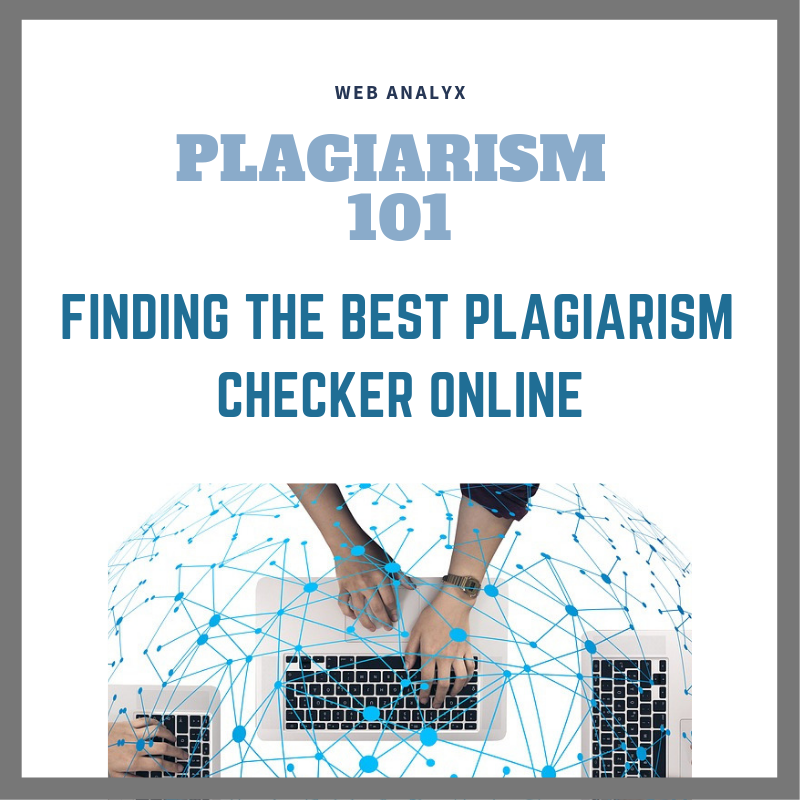The Internet is considered as a necessity nowadays. With the rise of technology, everything is now shared, saved and stored on the web. However, along with this innovation is the fact that the need for information and data became more and more in demand. On the first years of the internet, it is not a hidden fact that plagiarism became a big issue. Unfortunately, some students, researchers, bloggers, and everyone who called Google and several search engines for help were still uneducated about the term “plagiarism.”

As the web became more and more congested with information, therefore, the demand increased too. And at the same time, the plagiarism rate also, sadly, increased. However, is it still the situation today? Thankfully, as people become more knowledgeable about the issue, experts also have successfully developed excellent online tools to avoid and decrease the rates. In no time, plagiarism checkers certainly became a huge trend. But of course, ever since it was invented, lots of innovation had happened. There are not just one or a hundred plagiarism tools today. Thus, how can you be so sure that it’s the best plagiarism checker for you? But first, what does exactly plagiarism means and why did it “flourished” in the past years?
Different Types of Plagiarism
It is now an undeniable fact that plagiarism is still one of the biggest issues in today’s society, not just in writing but also to other forms of arts and creations. But of course, it is more widespread most specifically to the academic world. As we all know, plagiarism is the act of stealing or copying someone else’s work on purpose without citing or asking permission to its original and true owner. However, did you know that there’s a lot more to this issue? So that you know, here are some of the types of plagiarism you might want to be well aware of.
1. Mix-and-Match Plagiarism
Paraphrasing using different sources can be called as remix plagiarism. In this type of paraphrasing, one still uses the same set of words without even altering them. The texts seemed to be different at first, but the next contents are copied and pasted from the original documents.
2. Clone Plagiarism
The verb “clone,” according to Merriam Webster Dictionary has the simplest definition of “to make a copy of.” And when it comes to cloning plagiarism, it just really meant nothing but copying someone else’s work, word by word and submitting it as your own. This is the most obvious and most common type of plagiarism that is typically done by students. The first years of the internet are such a breath of fresh air and an incredible discovery, especially for students. Asking several search engines, such as Google and Mozilla Firefox become a trend. Unfortunately, most of these students are not yet that informed about plagiarism.
3. Self-plagiarism
For students and researchers, it is only reasonable that you will have to look back on your past write-ups. However, did you know that using them again for new research would mean self-plagiarism? If you will copy the very same context from your previous work without even paraphrasing or not altering your words, then you really did self-plagiarized.
4. Collaboration Plagiarism
This is another one of the most common types of plagiarism, many students and bloggers use different sources to make sure that their works are valid and accurate but failed to properly cite their references and paraphrase that particular part of the content.
5. Partial Plagiarism
If clone plagiarism means copying the whole statement, partial plagiarism means using or copying a specific part of the text as and adding it to your content as part of your own. The writing is not altered even a bit and just pasted to become a part of new material.
6. Unfound Source Plagiarism
Well, this type of plagiarism incorporates those types of contexts who successfully integrated the references, however, failed to cite the sources correctly. In short, the information about the sources was all wrong.
7. Bit-by-bit Plagiarism
When it comes to bit-by-bit plagiarism, it can be defined as an act of plagiarism that does not copy the whole original content but getting or copying certain words and phrases still, word by word. Typically, some commit this plagiarism by only changing the first word or phrase and then eventually just pasting the next passage from other’s work. The content and the idea of the context is the same and have not been altered even a bit too.
These are just the most common types of plagiarism you might encounter along the way. Plagiarism is not simple, and everything about the issue really involves complex and confusing rules. However, just to avoid this conflict from happening, there are some tricks you can certainly try.
Tips and Tricks to Avoid Plagiarism

1. Accurately Cite Your References
Who wants to get their works plagiarized? Well, plagiarism aside, it is only just and right for every one of us to recognize the work of the others. Most importantly if it was used and it helped as a reference to successfully finish your writings. However, you should also be aware to properly cite them because you might end up committing “unfound source” plagiarism if you failed on this part. There are actually the right formats to cite references based on the type of document you are creating. You might have a good intention, but it might still end up wrong without the proper knowledge.
2. The Purpose of Quotations
Understanding the purpose of quotations is very critical especially for writers and researches. This is one of the most common, simple, and yet the most powerful way to avoid plagiarism. Using quotation marks automatically means that you are paying respect to the real owner of the reference you have been using. But of course, you should know how to use it properly.
3. The Art of Paraphrasing
Being skillful in writing also means learning the art of paraphrasing. Of course, you still have to cite your references right, but paraphrasing and putting up a sentence in your own words means that you have also exerted an effort to make sure you still deliver the same message without using the words of others. Technical writers who need to deal with lots of technical jargons and technical terms certainly need to be really good with this skill.
4. Trust Your Own Insights
Of course, aside from learning the art of paraphrasing, trust your own insights. Contents and documents will never be original unless it’s from your own mind. Try to understand your topic first and give your own opinion about each context. Research and study until you get the real goal of your references and your very own document. Writing what’s on your mind will guarantee you a 100% original content.
5. Proofreading
Second to the last from the list is “proofreading.” Whatever you write, either it is an assignment, research, a blog or a news article you must give ample time for proofreading. It is inevitable to make grammar or typographical mistakes at times. Rechecking your work will not just assure you that you have correctly delivered your message to your audience through your document, but you will also have the chance to see if you have unintentionally forgotten to use quotations or improperly cite your sources.
6. Use the Best Plagiarism Checker
Just like what has been mentioned before, it is excellent that experts developed a great online tool like plagiarism checker to save us from all of these. However, as there as so many tools out there nowadays, it is really inevitable that you might have a hard time choosing the best plagiarism checker that will work for your needs and wants. Plus, a compelling and authentic plagiarism checker certainly has several characteristics that will prove their usability and user-friendliness. They must not only provide you a percentage of originality, but the possible acts of plagiarism must also be appropriately highlighted. The sources must also be mentioned and provided. A quality plagiarism checker has lots of characteristics that need to be achieved. If you happened to be looking for one, you could visit Web Analyx Website Analyzer.
Introducing Web Analyx
One proven plagiarism checker whom you can use is from the newly-developed Web Analyx. They offer an accurate plagiarism checker for students, researchers, bloggers, and writers. Especially and meticulously created by the experts, this tool has access to several large and private databases. Your project will be scanned and run through in these databases in no time, making sure that your work will receive the most accurate rating of originality.

The results will also be provided within just a few seconds and voila! The tool will present you the “plagiarized” part of your content and help you correct those through providing the original content. With that, you can have the chance to edit your content and make it 100% original. This plagiarism tool is just one of the several online tools you can find in Web Analyx. This website is offering lots of SEO and writing tools which can certainly help you maximize your site and your contents.







